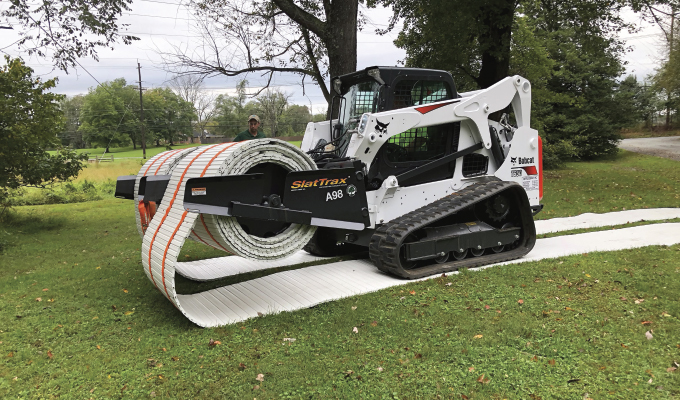Ground protection products are essential tools for contractors seeking to optimize project efficiency, minimize damage, reduce repairs and reclamation, ensure consistent access, and improve overall safety. Ground protection mats and temporary roadway products offer a range of benefits that contribute to cost savings, streamlined operations, and operator safety.
BIG BENEFITS
Equipment can get stuck when the ground is soft, which can cause delays and leave businesses, homeowners, or others frustrated with lawn and landscape damage. Ground protection products like temporary roadways, mats, or grids can be used to provide a rigid surface, making it easier for equipment to access the work area.
Ground protection mats are primarily used to prevent damage caused by heavy machinery and equipment. They distribute the weight of the equipment and help minimize soil compaction, rutting, and other forms of ground disturbance.
Temporary roadways are designed to provide a supportive surface for vehicles and equipment to gain consistent access to job sites. They serve as temporary access routes, enabling vehicles and equipment to reach work sites in areas where access is limited.
Temporary roadways can also help to minimize the risk of slips, trips, and falls. Deploying ground protection products enhances safety for crew members by providing them with a designated route through work zones.
Engineered ground protection and site access products are typically made from recycled materials, such as high-density polyethylene (HDPE) or other synthetic materials, which contribute to the reduction of waste. By incorporating engineered ground protection products made from recycled materials, contractors eliminate the need to repeatedly re-purchase plywood sheets.
WHAT TO CONSIDER
When selecting ground protection mats or a temporary roadway, it’s essential to consider various factors such as the weight and type of equipment, condition of the ground, duration of use, specific environmental considerations, and the area of coverage needed. Types of coverage can include roadways to ingress and egress or coverage areas for staging or work platforms.
Conducting a site survey in advance helps you select ground protection products that work best for your specific needs. A survey typically includes an evaluation of the ground conditions and identifies access and staging locations for the work.
Products come in a variety of materials, sizes, and thicknesses, so the strength, stiffness, and load capacity will vary. Some products interlock, while others don’t. Many require manual deployment. Some products feature tread patterns to improve grip for equipment. Consulting with suppliers is also a key step to help determine suitable options for a specific project.
SlatTrax is a unique linear roadway and ground protection system. One hundred feet of the manually deployed DIY product can be set up in 10-15 minutes. The hydraulicly powered single or double spool systems can deploy or retrieve 100 linear feet of road in around two minutes and mounts easily on skid steers and similar equipment. This unique system virtually eliminates manual labor and reduces the number of crew members needed to prepare or exit a site.
Hydraulic system spools are loaded with 100 ft. of Trax and can be reloaded with additional Trax sections that connect to quickly create stable service roadways. The Trax are available in rolled or pallet configurations for simple, fast, and easy deployment and retrieval. In addition, the compact, self-contained systems require less space for transporting and storing.
While cheaper, plywood has significant limitations in handling, traction, and longevity. It quickly becomes waterlogged, cracked, and splintered, and will need to be replaced frequently. As a result, plywood is typically not the best choice for long-term or heavy-duty ground protection applications.
Ground protection mats, such as AlturnaMats and VersaMats, are lightweight sheets which can be connected with linking hardware. These products are made of HDPE plastics and are resistant to breaking, cracking, splintering, and absorbing moisture or liquids. The mats are used to create work platforms, access roads, or temporary parking areas on construction sites. Their simplicity ensures stability and versatility, allowing for adaptation to different project requirements.
In some cases, heavy-duty ground protection and access matting is needed. Products such as TuffTrack XL, XtremeMat, MegaDeck, Dura-Base, and System 7 matting may be the ideal solutions. These synthetic ground protection mats are made for the heaviest equipment and worst conditions. TuffTrack XL mats are a one-piece solid material mat that conforms to the terrain. It is two inches thick and can support 150 tons of wheeled or tracked equipment. XtremeMat is a one-piece, roto-molded design with a solid foam core. It’s extreme durability and versatility far surpass timber mats.
MegaDeck, Dura-Base, and System 7 mats are constructed from two pieces that are welded or bolted together. They all provide stable work platforms or access roads in very harsh conditions. This type of matting is ideal for heavier equipment, extremely soft ground, or long-term jobsite needs. Each product has its own interlocking connection system.
In many cases, a combination of ground protection and site access products may be the most effective approach, especially when linear and area coverage is needed, as there is rarely a one-size-fits-all solution. The selection of appropriate tools depends on the specific needs of each project, and contractors should evaluate the options to determine the combination they believe is best for their needs.
By incorporating ground protection products into construction projects, contractors can reduce costs and improve efficiency by minimizing the need for repairs to the ground, while also improving worker safety.
ABOUT THE AUTHOR
Kevin Koberg is the strategic sales manager for DICA’s Ground Protection product lines. Koberg has worked in the family-owned business alongside his brothers Kris Koberg, CEO, and Kerry Koberg, sales director, since 2009. For more, visit www.dicausa.com.


